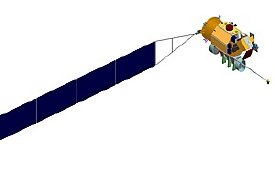Mar 3 2010
The National Institute of Standards and Technology (NIST) and the National Aeronautics and Space Administration (NASA) have launched a joint effort to gather enhanced climate data from spaceborne climate observation instruments planned for a group of satellites now under development.
 One of the three CLARREO satellites, which will make observations of the energy the Earth absorbs from the sun and radiates back into space. The balance between them affects the climate.
One of the three CLARREO satellites, which will make observations of the energy the Earth absorbs from the sun and radiates back into space. The balance between them affects the climate.
The Climate Absolute Radiance and Refractivity Observatory (CLARREO) Mission includes a fleet of satellites tentatively scheduled for launch later this decade that will gather data for long-term climate projections. The CLARREO mission will provide an accurate climate record of the complete spectrum of energy that Earth reflects and radiates back into space, measurements that should provide a clearer understanding of the climate system.
NIST’s role will focus on the calibration of the instruments aboard CLARREO satellites, as well as on the accuracy that the sensors must meet. The measurements need to be characterized to far greater accuracy—from two to 10 times better, depending on the wavelength of light in question—and detector standards need to be developed for the far infrared region of the spectrum. NIST will also help NASA improve its own capabilities in instrument calibration. The collaboration was finalized in a Space Act Agreement on Feb. 4, 2010.
CLARREO, led by NASA Langley Research Center in Hampton, Va., is now among NASA’s top-priority missions because of its high ranking by the National Research Council, which designated CLARREO one of its four “Tier One” missions when it evaluated proposals in 2007. NASA is allocating $270,000 for NIST’s contributions to the project this year.
The mission is part of a longer-term effort to establish global long-term climate records that are of high accuracy and traceable to the international system of units (SI). The CLARREO satellites and other instruments will be calibrated against international standards based on SI, so that observations from different times and locations can be compared usefully, creating a more reliable record of long-term climate trends.